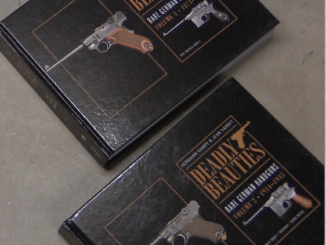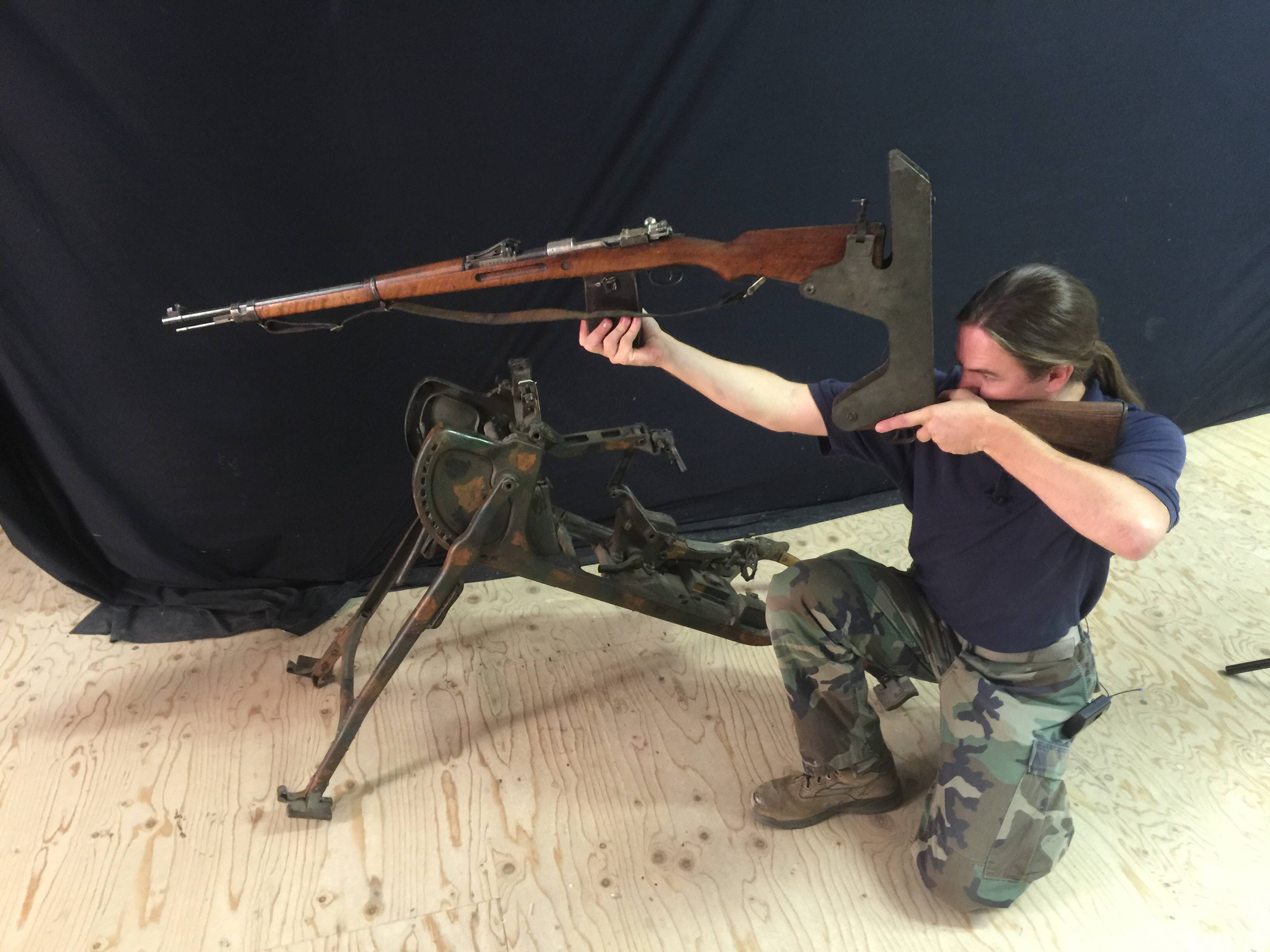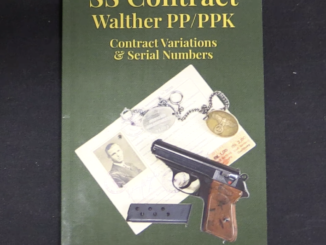This double-barreled sporting rifle made by Christoph Funk in Germany is not much like the typical over-under double-barreled rifle. It began as a fairly standard Mauser bolt action, chambered in 7×57 Mauser with a 5-round magazine and a nice double-claw scope mount. What Funk added to this was a .22 caliber rimfire action and barrel inside the front handguard of the Mauser action.
The .22 action is simple, and its barrel is very light – their addition does little to disturb the balance or handling of the gun. A striker cocking lever was added behind the Mauser bolt to actuate the .22 firing mechanism, and what appears to be a double set trigger is actually a trigger for the Mauser action and a trigger for the .22 action. A very clever way to allow a sportsman to have a round of proper rifle ammunition ready for medium game while simultaneously having a round of .22 rimfire ready for a shot at a small game animal.




It reminds me of the russian Los-11. Large caliber above and rimfire underbarrel, you have to change between two dedicated magazines though.
Both Petersen (The Great Guns) and Winant (Firearms Curiosa) illustrate crossbows combined with wheel-lock or matchlock arquebus. In both cases, the crossbow was a “prodd” or “stonebow”, intended to fire small metal or clay pellets to kill small game. The arquebus was a big-bore arm intended for heavy game.
The idea was that a hunting party out after boar, etc., could use the nearly-silent prodd to take small animals for camp meat without spooking the main quarry.
I suspect whoever this was made for (I’m pretty sure this was a custom job) had similar ideas.
I doubt it was intended for practice, as there were .22 conversion units available that would have fit the Mauser action and been much cheaper than this arm must have been.
The .22 action may be unique; a hinged or pivoting chamber with a chamber/ barrel interface much like a revolver. I’ve never seen or heard of one like it before, which lends credence to the theory that this was a one-off custom job.
Sort of the same logic was behind the Savage Model 24 over/under rifle shotgun. My mother owned one in .22 LR/20-gauge. While the 20-gauge was mainly thought of for birds, it could certainly take deer-sized game with slug loads, as my mother demonstrated during several deer seasons.
While it might make sense as an explorer’s or “survivalist’s” rifle, the time and place combined with the overall condition makes me suspect that this rifle was mainly a well-to-do gentleman’s “plaything”. 7 x 57 would be a reasonable caliber for a “light rifle” in Africa, and .22 would be a decent foraging caliber.
It might have been made for a man intending to go on safari in Kenya, who didn’t want to cart along a separate .22 rimfire in addition to his light rifle (for soft-skinned game) and heavy rifle like a .375 or, being German, possibly a 9.3 x 62 Mauser.
The Zeiss 4x scope would be intended for use at about 200 meters, which is consistent with both European an African hunting conditions. A matching “heavy rifle” would probably have an identical scope.
I can’t see much use for such a setup in Europe in the interwar period, leaving Africa as a “least unlikely” end-use area for this one.
cheers
eon
From the markings this started out as a standard German hunting rifle that was later, maybe after “liberation”, converted in England to this double barrel design. There’s clearly London proof markings visible next to the rather crude 7×57 mark. The auction listing actually shows it better than the video.
Nope, it was a Funk design that he did list in his catalog, as well as acquire a Deutsches Reich Patent on. This may be the original one that was made for a Canadian doctor. Would Canada pre-WWII have required British nitro proofing? Some proofmark maven knows the answer to that, and probably thinks I’m a dummy for asking.
Wonder how effective the gas sealing of the .22 lr chamber to its barrel was. Would it foul the inside of the rifle’s forearm? I would have attempted a Browning T-Bolt type mechanism.
Operating system of the .22 lr mechanism looks like an accidental discharge waiting to happen. Not a rifle for the casual shooter.
Agreed. Maybe if the .22 barrel had a more conventional method of loading and perhaps a detachable magazine, this could have gone into full production. I could picture a toggle-action similar to that on Olympic biathlon type rifles being used but this would require some way to ensure that the handle wouldn’t snag and dump a live round somewhere in the bushes… Any ideas as to what could be used?
I was thinking a T-Bolt with an M-16 spring-loaded latch on the bolt handle, to lock into the boltway at the front when in battery.
Even sneakier, a T-Bolt with a rotating bolt handle like the one on this one, locking into a slot rather like the safety slot of an MP40 or Sten.
Keep in mind that DWM and others made .22 trainer versions of the K98 with five-shot magazines that fitted in from underneath like the magazine in a .22 pocket automatic. So fitting a magazine in the forend wouldn’t be much of a problem.
The major thing I see with this would be barrel regulation and zeroing. Ideally, I would do one of two things;
1. Once the barrels were properly regulated (and that would have to be done by the gunmakers themselves), zero the scope with the 7 x 57 at 200 meters, then find a .22 LR load that shot center with the scope at 50 meters, and use only that load in the .22.
2. Zero the scope with the 7 x 57 at 200 meters, then zero the iron sights with the .22 at 100 meters. After which I’d ascertain exactly how far “up” or “down” the 7mm shot with the irons zeroed for the .22, and how far off the .22 was with the scope zeroed for the 7mm. And make very sure I remembered those figures.
Honestly, I’d have to say just carrying a .22 pistol along (where legal) would have been easier and less expensive. But IIRC, most African counties, especially under British colonial rule, took a dim view of pistols in the hands of even local civilians, let alone tourists.
Which may be all the explanation needed for this rifle.
cheers
eon
Okay, then how about a separate set of iron sights offset to the right just for the .22 barrel in the style of a Type 92 Heavy Machine Gun? I will admit that would add mass, but it might forego the zeroing troubles mentioned… Can anyone else find ideas crazy enough to work?
The problem with that is lateral stringing of groups. Offset sights tend to cause people to unconsciously “cant” the rifle to one side or the other to get a proper cheek-weld on the stock while keeping the master eye behind the sight. (Shooting with other arms with offset sights, such as a Hall breechloading rifle or a Bren on single-fire, tends to illustrate this graphically.)
The .22 barrel being directly below the CL boreline of the 7mm barrel was no doubt intended to avoid this problem by using only the 7mm sights. A second set of sights offset to one side sort of defeats the purpose.
In his novel The Master Sniper, Stephen Hunter described a similar setup on his “Vampyr” Stg44, made necessary because the IR scope system totally blocked the iron sights. The steel carrying case of a ZF4 scope was attached to the side of the Vampyr mount, with a set of pistol-type sights in it with the rear sight offset to allow for parallax and the fact that it was almost three inches off-boreline to the left. This allowed the shooter to move his head slightly, and lock in to a target at 50 meters for CQB. (In the end, it didn’t do Repp a bit of good.)
Probably the best solution would be Elmer Keith’s old trick of inlaying a gold or silver bar in one groove of the front sight’s aft ramp, to be the elevation marker for the .22. Or the scope could have a ballistic cam like the old Leatherwood ART with two settings; one for the 7mm, the other for the .22.
You’d have to remember which barrel it was set for, though, when that trophy antelope came sniffing about…
😉
cheers
eon
I agree with eon that it is probably a one-off rifle. I have seen many “doubles” ranging from Big-Bore Express doubles from .600 Nitro Express to 2-bore double muzzleloaders. That’s a full half-pound ball in each barrel in case you ask! I have even seen a “double” over/under flintlock with rotating barrels. My next question on this one is if the two barrels are “regulated” to use the same aiming device (scope vs scope/open sights) and how accurate the .22 is based upon this question. I am not familiar with the arquebus/harquebus/hackbut-crossbows combination but would like to see one. For a peek at a really unique multi-barrel arquebus go to the pictures at http://www.vikingsword.com/vb/showthread.php?t=12712. I worked with Gil Frey back in my days as a member of The National Crossbowman on some of the first compound crossbows and saw a lot of very weird examples early crossbows but never the combination of these two weapons. I will try to look it up and thanks again, eon.
There is a book about the “Christoph Funk Gewehrfabrik Suhl” by Peter Ravn Lund, published by himself (www.bryndumlund.dk). An except is found at http://www.korsholm.dk/media/wysiwyg/PDF/Funk-Suhl.pdf. Funk produced guns from 1835 right up to 1960.
Likely one-of-a-kind, and nice if you don’t know whether there’s a deer, a boar, or a rabbit around the next bend…but like most combination guns, it probably isn’t as practical as it would seem. I hunt with a drilling from time to time when I plan on just taking a walk in the woods without any particular quarry in mind, but only once in all of these years have I actually used the rifle barrel, although the shotgun barrels get used fairly regularly. On that one excursion, I bagged a limit of ducks and rabbits, then finished off the day with a nice little eight point buck. We ate well that week. Still, it is a bit heavy but it’s nice having that 30-06 hanging around just in case.
I don’t think it’s one of a kind, because (1) Funk took the trouble to patent it, and (2) this one seems different from the one in the book Christoph Funk: Gewehrfabrik. This sample of the book shows part, but not all, of the information on the gun. Funk said he made it at the behest of a Canadian hunter who wanted to have a single rifle for big and small game, so Ian’s guess as to its purpose was right in the X ring.
http://www.cornellpubs.com/downloads/Funk-Suhl.pdf
A slight incentive to have one could be to reduce the red tape in countries where guns were registered, and where such a set up would count as one gun, not two. Would also be handy for trips on horse back to the back country where space and weight were at a premium.
The 22 action along those lines could be very compact, looks like the sort of thing that could be used in a “Day of the Jackel” type assassin’s weapon.
In the older 19804S kETTNER catalogues here in france
they adveertized a short(10cms)?reducer tube chambered in .22lr or .22 magnum
This was intended for single or double barrel rifles
Rather then for practice or small game the add said it was specificully for use in giving the coup de grace to roe deer or red deer
Obliously this would involve a head shot that in a major calibre ie7x57 would damage the skull for mounting esopecially on roe deert
This might explain the combination on the mauser as a simple solution with no extra parts to take hunting and perhaps eventually lose
Pfeifer in Austria offered a similar conversion some time ago, but in .22 Hornet.
It’s not on their current homepage, but I managed to locate it in the Internet Archive:
http://web.archive.org/web/20071012151022/http://pfeifer-waffen.at/cms/html/index.php?module=htmlpages&func=display&pid=14